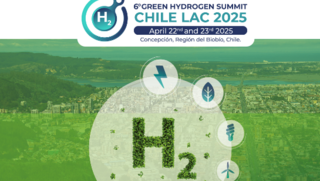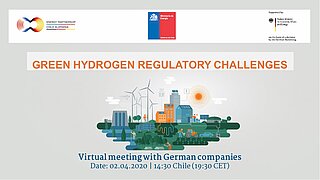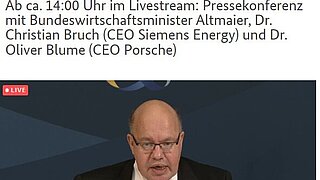Germany´s National Hydrogen Strategy

Germany places great hopes in hydrogen as a key element for advancing the energy transition and adopted it´s National Hydrogen Stragety in 2020. This strategy has been updated in 2023 and is published in it´s latest versions that include an Importstrategy for Hydrogen and its Derivatives on the website of the Federal Ministry of Economics and Energy (BMWE) where you can find further information in German, English and French.
On 10 June 2020, the Federal Cabinet approved a National Hydrogen Strategy for Germany which has been updated in 2023 and since July 2024 it includes an import strategy for hydrogen and it´s derivatives. The follow up versions respond to new marked demands and other climate protection ambitions aiming to reach climate neutrality in 2045.
Within the framework of the latest hydrogen strategy, an import strategy has been elaborated, recognizing on one hand that Germany will not be able to meet it´s own demand due to very high need for hydrogen to replace fossil fuels specially in it´s steel industry. That´s how the Import Stategy for hydrogen and hydrogen derivatives has been elaborated supplementing the National Hydrogen Strategy (NHS). Published in July 2024 the strategy aims to ensure resilient supply of sufficient hydrogen and its derivatives focussing in sustainable, secure, stable and therefore diversified supply of sufficient hydrogen, sending at the same time a clear signal to partner countries and companies about Germany's need and willingness to import hydrogen and hydrogen derivatives. It thus makes an important contribution to improving the security of investments in hydrogen production in our partner countries and in the construction of the necessary import infrastructure.
The strategy expects a need of 95-130 TWh of hydrogen and hydrogen derivatives by 2030, of which 50-70% must be imported. By 2045, the need is expected to increase to 360-500 TWh for hydrogen and 200 TWh for its derivatives.
This expectations need not only to increase hydrogen production itselve but also to accelerate respectivly the construction of secure infrastructure and networks aswell as regulatory and certification frameworks to enable hydrogen transport, import and suply.
By using hydrogen produced in a climate-friendly way, areas of industry that are reliant on the use of liquid or gaseous energy carriers can decrease their carbon emissions significantly. Hydrogen can be utilised, for example, as a feedstock in the chemical and steel industries or as a fuel in fuel cells. It can be put to beneficial use whenever electricity cannot be generated from renewable sources directly. The production of 'green' hydrogen from renewable electricity and water (via electrolysis), makes it possible to store and transport renewable energy.
Five (now: 10) gigawatts of electrolysis capacity for green hydrogen by 2030
By 2030, it is expected that the scale of Germany's hydrogen demand will equate to around 95 to 130 terrawatt hours (TWh). In order to promote the development of a strong domestic market, Germany plans to build its first green hydrogen generation plants with a total capacity of up to ten gigawatts (GW) by 2030, including construction of the offshore and onshore infrastructure needed. This ambitious target corresponds to an additional electricity demand from renewables of 20 terawatt hours (TWh).
In order to cover the remaining demand, Germany will need reliable production and transport partners as well as established cooperation and import structures, especially in the EU. Having these partners and structures in place will also provide an opportunity for expanding the European internal energy market and cooperating with countries in other world regions that have high levels of sunshine and wind (which have great potential in the field of renewable energy), as described in the National Hydrogen Strategy. Germany could import from these countries the valuable green hydrogen it needs in order to increase its own production. Its domestic gas infrastructure will also have to be adapted to handle hydrogen – a further issue that is also taken up in the National Hydrogen Strategy. The strategy is taking in acocunt the import of hydrogen through hydrogen pipelines as well as the adaption of port infrastructure for "green shiping corridors" needed to import hydrogen via ship transport.
Chile producer of hydrogen
Due to its optimal natural conditions with abundant solar and wind energy Chile is considered an outstanding location for green hydrogen production. Chile's early development of a hydrogen strategy and complementary action plans in 2020 have positioned the country as an attractive economic partner and for investment in hydrogen technology. That´s how also the German government wants to partner with Chile in the field of hydrogen, as it shows by our multiple projects in the hydrogen sector.
In 2023, Chile established an interministerial hydrogen council (‘Comité Hidrógeno’). In May 2024, the Ministry of Energy published the Green Hydrogen Action Plan 2023-2030, with the aim of providing the world's cheapest green hydrogen by 2030. These partnerships on the new hydrogen industry are able to foster energy transition on both sides on one hand and positioning both sides in a leading position in their respective world region.
The Chilean Green Hydrogen Action Plan | The Green Hydrogen Action Plan 2023-2030 will define the roadmap for the deployment of this industry, balancing economic development alongside environmental, territorial and community respect. You will find further information about the Green Hydrogen Strategy of the Chilean Government on this website: https://www.planhidrogenoverde.cl/




